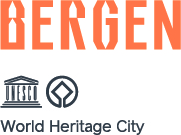The most famous churches in Bergen are Domkirken, Mariakirken and Fantoft stavkirke. But Bergen has many churches worth visiting!
Early on, right after Christianity was established in Norway around the year 1000, so-called post churches were built, with a construction technique quite similar to stave churches. Unfortunately, none of these have survived. After the post churches came the stave churches, and eventually they went on to build churches in stone. Regardless of the material used, most so-called long churches were built, and long churches are now seen as the typical Norwegian church form.
In Bergen we have several historic long churches, Mariakirken is one of these. Although a large number of churches of newer churches are built in stone, the furniture is most often made of wood.
Below the description of the churches you will find a useful map that shows the location of each church. Please note that the churches have limited opening hours so it is not certain that you will have the opportunity to visit the churches inside.
Mariakirken (St. Mary's Church)
Mariakirken is one of the oldest buildings in Bergen and is estimated to have been built in the period between 1140 and 1250. The church is located just behind Bryggen and was used by the Germans during the Hanseatic era. That is why it is often called the German Church by the locals.
 Photo: Erik Wassenaar
Photo: Erik Wassenaar
St. Mary's Church is a long stone church with a basilica shape and two towers. It was built in Romanesque style, but has partially burned down twice, and other building styles influenced the rebuildings. The choir is, for example, Gothic, while the pulpit is in baroque style. The furniture is beautiful and Mariakirken is a popular attraction among both tourists and locals.
Read more about St Mary's Church, visiting hours and location.
Domkirken (Bergen Cathedral)
Domkirken is located near the Leprosy Museum, just a few minutes from the train station. The church as it appears today, includes the remains of two older churches, dedicated to Olav the Holy and dated back to 1150. The church is a long stone church and is the parish church for the Cathedral congregation in Bergen. After being damaged in several of the many city fires, the church has changed style repeatedly. At the end of the 19th century, among other things, the Rococo interior was removed in favor of a more typical medieval style with four Gothic columns.
 Photo: Hans Knut Sveen
Photo: Hans Knut Sveen
Behind the church you will find a small cemetery and Bergen Cathedral School, one of the country's oldest schools, is the church's nearest neighbor. The cathedral often houses concerts in addition to Sunday Masses.
Read more about Domkirken (Bergen Cathedral) and see when it is open for visitors.
Fantoft stavkirke (Fantoft Stave Church)
Fantoft stavkirke is a reconstruction of Fortun Stave Church, dated bact to 1150, which was moved to Bergen in 1883. The church was set on fire by the controversial musician Varg Vikernes in 1992. Stave churches are very different in appearance from other churches we know from the Middle Ages. This is rooted in the building customs of Northern Europe, where wood was the primary material they could use. The name Stave Church has appeared recently and refers to the construction method.
 Photo: Visit Bergen / Casper Steinsland - visitBergen.com
Photo: Visit Bergen / Casper Steinsland - visitBergen.com
Fantoft stavkirke is very nicely lit in the evening and a visit in the evening creates a very special atmosphere. Maybe you get the feeling of being in the film Frost, much of the architecture in that film is based on Norwegian stave churches.
Fantoft stavkirke is located outside the city center. Take the Bergen light rail to Fantoft (The Bergen light rail takes about 18 minutes from the city center to Fantoft), and then follow the signs (10 minutes to walk)
Read more about Fantoft Stave Church, the opening hours and how to get there.
Johanneskirken (St. John’s church)
With its reddish color and easily visible location on Sydneshaugen, Johanneskirken is a well-known landmark in the city. From the top of the 76 steps that lead up to the church, you have a great view over the city center and towards the mountains to the east. Johanneskirken is a long stone church that was built in 1894 in neo-Gothic style. The church has Bergen's tallest church tower with 61 meters as well as the largest church room in the city. Inside you will find an impressive wooden ceiling and a large organ with a Gothic front. Johanneskirken is also the location of Bergen's only carillon, mounted in 2014, with a weight of as much as 15 tonnes.

Photo: Bergen Domkirke menighet
The church can accommodate 690 people and is widely used for organ concerts in the summer and Christmas concerts in the run-up to Christmas. In the same area on Nygårdshøyden you will also find the University Museum of Bergen, which is well worth a visit.
St. Jørgen kirke (St. Georges church)
St. Jørgen kirke belongs to St. Jørgen Hospital, which is today known as the Leprosy Museum, and can be visited from mid-May until the end of September. The church is still used for services, weddings and concerts outside. It is a beautiful wooden church with a square shape. It dates back to 1706, when it was rebuilt after a city fire, and was originally a church for the lepers who lived in the hospital the church belongs to. The main picture on the altarpiece is from 1733 and shows Jesus with the ten lepers.
 Photo: Bergen City Museum - Gunn Kristin Monsen
Photo: Bergen City Museum - Gunn Kristin Monsen
St. Jørgen hospital is one of a few preserved leprosy hospitals in Northern Europe, and was in operation from about 1400 until 1946, when the last two leprosy patients died. The buildings have changed very little since then, and today's Leprosy Museum tells the Norwegian history of leprosy and the importance of Norway's contribution internationally. If you want to Explore more of Bergen you can find all of Bergens attractions here.
Korskirken (Church of the Cross)
Korskirken is probably somewhat less well known, despite its central location near Fisketorget. It was built at the same time as the oldest churches in Bergen and has undergone the same style changes as e.g. Domkirken. Many believe the name Church of the Cross is because of the church's architecture, but it was originally a long church. The name actually has its background in that the church was dedicated to the Holy Cross.

Photo: Kirkens Bymisjon
The northern portal in soapstone is considered to be one of the finest Renaissance portals in Norway. The church is of great social significance today due to the voluntary work that the Church's City Mission do. Korskirken is open daily and many activities are organized there - everything from masses, meditation and waffle serving, to Christmas celebrations.
St. Pauls kirke (St. Paul's Church)
St. Paul's kirke, located a few minutes from the Grieg Hall, is a Catholic church that was completed in 1876. The church houses the largest Catholic congregation in Vestland county and belongs to the Oslo Catholic Diocese. Due to lack of money, the construction of the church took 11 years, and the parish priest traveled on many trips around Europe to raise money.

Photo: Hege Askvik
The church is a long church built in stone and marble. The choir has stained glass windows and a large crucifix hangs over the high altar. Since Norway has been Protestant since the Reformation, the church's Catholic congregation has largely consisted of people born outside Norway, and today there are now approx. 120 nationalities represented in the parish register!
Nykirken (The “new” church)
Nykirken got its name because when it was built in 1621, it was the newest of the town's parish churches. The church is located close to Vågen and has also undergone changes repeatedly after city fires. It has a mansard roof and bell tower, and was one of Bergen's most modern buildings at the beginning of the 19th century. The new church was originally built with a low tower helmet instead of a spire due to economy, but in 1955 the church spire was built according to the original plan.

Photo: Bergen Domkirke menighet
Inside the church you will find the Baptism Angel, a beautiful angel with gold-colored clothes and wings, which is hoisted down over the baptismal fountain when baptisms are performed here. Nykirken is often called the Children's Cathedral, and is a cultural church with a strong focus on children. The new church is located on the road between the city center and the Bergen Aquarium.
Slettebakken kirke (Slettebakken church)
In the 1960s, Slettebakken parish needed its own church building. In the architectural competition that was held, Tore Sveram's proposal, a design of a very modern church, was announced as the winner. The design was strongly influenced by the architecture of the time and the draft was seen as radical. Sveram was inspired by St. Mary's Cathedral in Tokyo.
 Photo: Ingrid Fluge-Hole
Photo: Ingrid Fluge-Hole
The church was consecrated in 1970 and is built in concrete, has a copper roof, and even the interior has concrete as its primary building material, which was typical of the time it was built in. From the outside it can look like a ship with a high bow pointing to the sky .
Although the church is very young in this context, it is a so-called listed church. That means it is considered a cultural monument worthy of protection by the National Heritage Board. The church is easy to get to thanks to the city light rail (the city light rail takes about 16 minutes from the city center, get off at the stop called Slettebakken), and located close to Tveitevannet it is easy to combine the visit with a leisurely walk around the water.
Åsane gamle kirke (Aasane old church)
At Saurås in Åsane, there has been a church since the 16th century. The origin of the current church was built around 1795, and was a small and simple long church in brick with wood in the gables. A charming type of church that is commonly found in rural Norway. Åsane kirke was kept alive with gifts, as the farmers who attended the church paid tithes to nearby Hamre church instead.

Photo: Magne Fonn Hafskor
On Christmas Eve 1992, Åsane gamle kirke was set on fire, but a copy of the original church was completed in 1995. Åsane gamle kirke is located 20 minutes walking distance from Åsane terminal where the busses (the bus ride takes 15-20 minutes) from the city centre stops, and 7 minutes from Ikea, to which there is also a bus connection.
Do you want to learn more about Bergen's exciting history? Join a guided tour and learn more about Bergen along the way.
 to add an item to your Itinerary basket.
to add an item to your Itinerary basket.



 Photo: Erik Wassenaar
Photo: Erik Wassenaar



